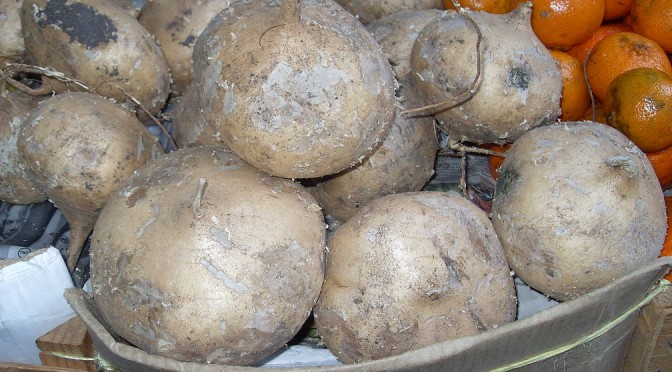Oddly, even though I grew up adjacent to Mexico and thrived on Mexican food, jicama was something I really didn’t encounter. Not even when I moved to Southern California. I didn’t “discover” it until about ten years ago when I spotted the odd-looking root in the grocery and decided to try it. What I found was an unusual vegetable that has a crisp, clean flavor and a bit of sweetness. It reminded me of an apple in texture and in crunch.
Most frequently, jicama seems to be cut into small sticks or grated and put into salads and slaws, where it does an admirable job. It can also be cooked, baked, boiled or fried. One of the interesting characteristics is that it doesn’t get soft. It keeps the crispness, which makes it great for a dipping chip, even if you fry it. It adds a bit of crunch to a stew while substituting for a higher carb’d vegetable.
Cultivated South of the Border
Pronounced hee-ca-ma, it is also called yambean, although it is not a yam. Jicama is native to Mexico and South America. It is part of the legume family and grows a vine in tropical and semi-tropical climates. The edible jicama root is a globular shape and has been referred to as Mexican turnip, although the flavor is nothing like a turnip, or Mexican water chestnut, which it resembles in crunch. Other names for it are bengkoang, sengkwang and yacon. The flavor suggest that it would also be good in Asian food as a water chestnut substitute. It is grown in Asia and in other tropical and semi-tropical areas, including Florida, Hawaii and Puerto Rico.
Nutrition Info per 100g (about3.5 oz)
Calories: 38 Fat: 0.19 g Net Carbs: 3.8 g Protein: 0.72 g
Jicama, how do I love thee?
Let me count the ways:
- Peeled and cut into sticks as a snack.
- Cut into rounds and fried as a dipper instead of potato chips.
- Chopped and added to stir-fry.
- Shredded and added to salad.
- Cut into sticks and Tampura battered and fried.
- Sliced and spread with peanut butter and sugar free jam.
- Sliced and sprinkled with cinnamon and sugar substitute.
- Sliced and roasted, then topped with cheese and bacon.
- Sliced and sprinkled with lime juice and a bit of chili powder.
- Cut into cubes and mixed with strawberries and blueberries in a fruit salad.
- Or mixed with cantaloupe and honeydew melon in a fruit salad.
There are more ways than I can count to use this versatile vegetable. If you have other ways you’d like to share, let me know.
Here are two ways to use jicama from this site:
Root Vegetable Fries (on the Celeraic page, go to the bottom)
Sizzlin’ Hot Snacks (toward the bottom, snack options with beets, daikon and jicama)
And here’s a new recipe for jicama for this entry:

Cinnamon Battered Jicama Sticks
12 Jicama sticks, about 3 to 4” long, 1/2 inch cubed
1/4 cup Low Carb Flour
1 Egg
1/4 teaspoon Baking Powder
1 teaspoon ground Cinnamon
1/2 teaspoon ground Cardamom
2 tablespoons Sugar Substitute
1/4 cup sugar free Raspberry Jam or preferred flavor
Coconut Oil
Mix the flour, egg, baking powder, sugar substitute and spices together to make a batter.
Heat enough coconut oil in a small pan to bring it to about 1/2 inch. Reduce to a medium heat.
Dip a jicama sticks into the batter, then carefully slide into the pan of oil. Cook about three at a time until golden brown, then turn over to cook the other side to golden brown or spoon the oil over the top while cooking to brown the top. This only takes a couple of minutes. Remove to paper towels to drain. Spread with sugar free raspberry or other jam of choice.
Makes 12 snacks.
Nutrition info per snack
Calories:16 Fat: 0.7 g Net Carbs: 2.0 g Protein: 0.8 g
All comments relevant to my posts are welcome. SPAM is not. If the post has nothing to do with my site content, it will not be posted.
This article used the following for reference: Specialty Produce, Nutrition and You, Natural Society Newsletter
Top photo from WikiCommons, used with permission – By Wicki (Own work) [Public domain], via Wikimedia Commons


You truly are so adventurous to try new things! I have never heard of these before.
–Mee (The Chinese Quest)